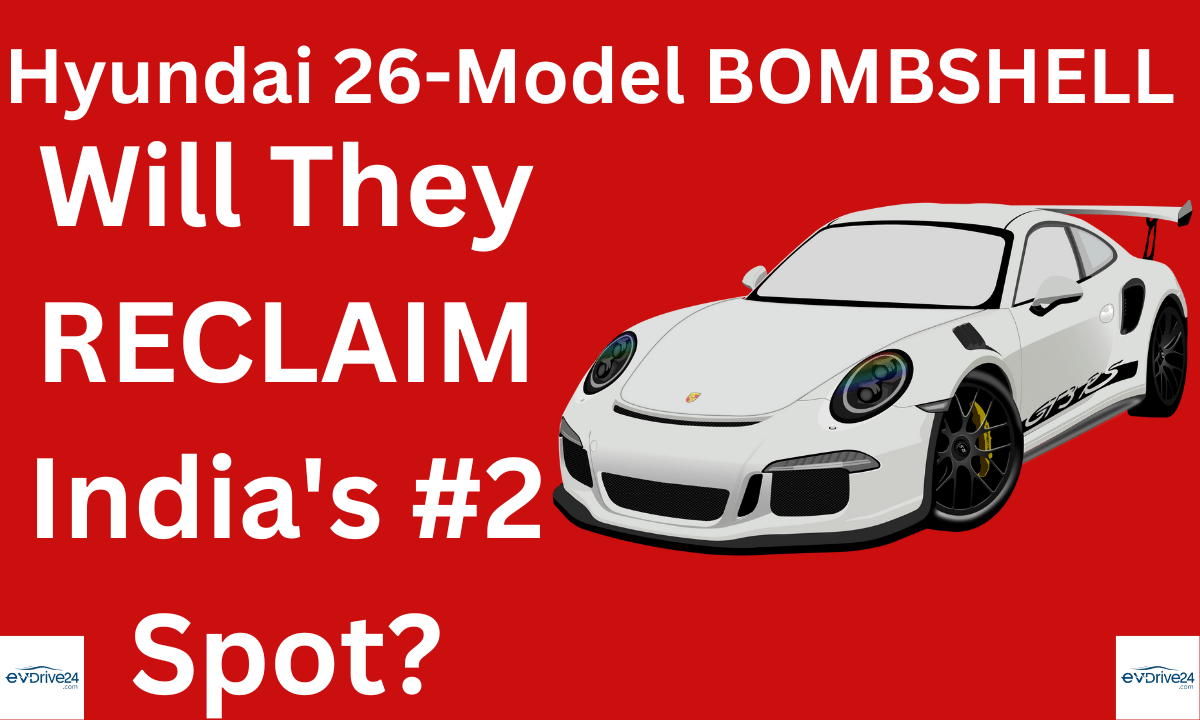Hyundai is under pressure in India, but a massive product offensive with 26 new models, including exciting EVs and hybrids, aims to secure their #2 spot. Discover Hyundai comeback plan!
Hyundai Motor India, a powerful company that has been in India since 1998, has recently hit a critical point in its journey. Although they just had a successful IPO (Initial Public Offering), Hyundai’s strong number two position in the Indian market is now severely threatened, even dropping to the number four spot in the first few months of the last financial year.
This change has been a “massive surprise” to the market, especially as Indian brands like Tata Motors and Mahindra & Mahindra have gained significant ground, mostly due to their impressive range of SUVs.
So, why has Hyundai faced these challenges, and what’s their plan to fight back?
Why Hyundai Faced Pressure
Several reasons have led to Hyundai’s recent struggles:
- Fewer New Products: In the last two and a half years, Hyundai hasn’t launched many new major products, while its competitors, Tata Motors and Mahindra & Mahindra, have introduced many new SUVs.
- Too Much Reliance on Creta: Some believe that Hyundai depends too much on just one model, the Creta. People even joke it’s “Creta Motor India” instead of Hyundai Motor India. While Creta is very successful, relying on one model makes them vulnerable.
- Products Not Selling as Expected: Even well-designed cars, like the Xter compact SUV, aren’t selling as much as they should, especially when compared to rivals like the Tata Punch, which is doing much better.
- Focus on Profits After IPO: After going public, Hyundai had more stakeholders and rules to follow, which might have made the company less quick and bold in taking risks. The main focus shifted to protecting and boosting profits (bottom line) instead of aggressively increasing sales volumes.
- Challenges in the Mainstream Market: The market for cars costing under 12 lakh rupees, which is the main part of the market, has been struggling. This affects sales for companies like Hyundai, Tata Motors, and Maruti Suzuki, which sell a lot of cars in this price range.
- Middle Management Issues: Compared to Maruti, Hyundai’s middle management and regional teams might not have as much power to make quick decisions, which could slow down sales efforts across the country.
- EV “Wow Factor” Missing: Hyundai’s Creta EV, though well-engineered, has seen disappointing sales because it doesn’t have the unique “wow factor” that electric vehicle buyers want. Customers buying EVs are often looking for something that stands out and looks different, not just a petrol or diesel car that’s been converted to electric.
Hyundai’s Ambitious Comeback Plan: A Flood of New Models
Despite these difficulties, Hyundai is a huge company with “a lot of firepower,” global research and development (R&D), plenty of cash, and the ability to use resources from its worldwide operations. India is their third most important global market, showing how committed they are.
To bounce back, Hyundai has announced a huge wave of new products, planning to launch 26 new models. While many of these will be updated versions or variations of existing cars, it still means a large number of new vehicles are coming.
Here’s a look at some important upcoming products and strategies:
- New Venue (October 2025): The completely new Venue is expected to be like a “baby Creta” and aims to increase its monthly sales to 10,000-11,000 units.
- New Crossover (Bayon, Mid-2026): Hyundai will introduce a brand-new type of vehicle, the Bayon, targeting the popular 12 lakh crossover market. It might come with a new 1.2-liter TGDI (turbocharged gasoline direct injection) or a 1.2-liter hybrid engine, showing their move into new segments and different engine types.
- First Mass-Market EV (H1i, End 2026): Hyundai’s first affordable, mass-market electric vehicle is planned for late 2026. This EV will use a completely new platform designed for EVs in the 20-30 lakh price range, different from their more expensive eGMP platform. It might use a more cost-effective 400-volt system for markets like India. Hyundai’s future EV lineup will include both cars converted from petrol/diesel and those built specifically as EVs (“skateboard” EVs).
- Palisade (Around 2028): This large SUV, expected to cost around 50 lakh rupees, will be Hyundai Motor India’s first hybrid vehicle. Hyundai believes its strong road presence will appeal to the Indian market, helping it succeed where other premium cars like the Tucson haven’t.
- All-New Creta (SX3, February 2028): The very popular Creta will get a brand-new generation, offering petrol, diesel, hybrid, and EV versions. Hyundai is investing heavily in this model, aiming to make it even better. The company also plans to keep its models in production for longer, but with more significant updates in the middle of their life cycle to keep them feeling fresh.
- Updates to Current Models: Facelifts (updated looks) are planned for models like the Verna (April 2026) and an update for the Xter (mid-2026). New generations for the Neos and Aura are also being considered.

Key Strategies for the Comeback
Besides launching new models, Hyundai’s plan involves several important steps:
- Focus on Hybrids: Hyundai believes that hybrid cars will be “extremely critical” for attracting customers, especially in the popular mid-size SUV market. However, the challenge will be making them affordable, especially if there are no tax breaks, and locally producing hybrid batteries and powertrains.
- Major Investment in India: Hyundai is investing over one billion dollars in R&D in India, in addition to more than 10,000 crore rupees for developing new products. Having local R&D is vital for speed, saving costs, and designing products specifically for the Indian market. They are also expanding their R&D facility and opening a new manufacturing plant in October 2024.
- Staying in All Segments: Unlike some competitors, Hyundai is choosing to stay in car segments that are not growing, such as sedans and hatchbacks. The reason is that if they leave these segments, it’s hard to come back. These segments still sell a good number of cars, help them achieve larger production scale for shared parts (like engines and transmissions), and support their export volumes.
- Feature-Packed Cars: Hyundai is known for being the “first-in-class” with new and exciting features. They plan to continue this by making high-end features, like sunroofs, available in lower and more basic versions of their cars. This is a response to Indian customers who want more features, even in entry-level vehicles.
- Using Global Strength: Hyundai can use its global resources, R&D capabilities, and financial strength to develop products. Being able to draw from its worldwide operations makes it a “formidable” (very strong) player in the market.
The Road Ahead
The next 18 months are expected to be “extremely challenging” for Hyundai. While they are making big moves, some difficulties remain, like matching Maruti’s lower production costs for hybrids and the ongoing challenge of succeeding in the very high-end (30-35 lakh+) car segments in India.
The idea of launching the Genesis luxury brand is also seen as a possible “distraction” from their main business. However, Hyundai is actively working to improve its sales network, believing that their current products could sell even more if the network is stronger.
Overall, Hyundai is a company that “can never ever be underestimated”. With a clear focus on new products, smart investments, and using its global strengths, Hyundai is well-positioned to fight back aggressively and aims to regain its top spot in the Indian automotive market.

